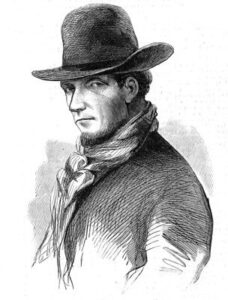 Albert W. Hicks was born in 1820 in Foster, Rhode Island. Even as a young boy he exhibited the stubborn and contentious nature that would later characterize his criminal behavior as an adult. As a young boy working on his father’s farm, he came to abhor the drudgery of the manual labor. Years later, looking back on his youth he said “My only ambition was to be rich; but I had no desire to acquire riches in the plodding way our neighbors went through life.”
Albert W. Hicks was born in 1820 in Foster, Rhode Island. Even as a young boy he exhibited the stubborn and contentious nature that would later characterize his criminal behavior as an adult. As a young boy working on his father’s farm, he came to abhor the drudgery of the manual labor. Years later, looking back on his youth he said “My only ambition was to be rich; but I had no desire to acquire riches in the plodding way our neighbors went through life.”
At the age of fifteen, a restless Hicks ran away from home and traveled to Norwich. It was here he committed his first criminal act. Hanging around the downtown train station he took the opportunity to steal a package from the baggage recently offloaded from a train. Norwich authorities apprehended Hicks several days later at his family home in Rhode Island.
He was convicted of theft and sentenced to several months in the Norwich jail which was predominantly populated with adult males. He escaped from the jail twice and was captured each time. The second escape resulted in the judge sentencing him to over one year in solitary confinement in the prison on Jail Hill. It was during his year in solitary confinement that Hicks came to this conclusion: “I imagined the world had declared war against me, and I determined as soon as my term of imprisonment should expire, to war in turn upon the world.”
By his own account, during the next twenty years, Hicks traveled throughout the Western Hemisphere from the California gold fields and Mexico to the whaling ports of the Sandwich Islands (Hawaii), as well as South America. During that time, it is estimated that he and his partner Tom Stone murdered at least one hundred persons during onboard mutinies of seagoing merchant ships and countless robberies on land.
Hicks’ trail of murders reached its conclusion with his arrest and trial in New York City in 1860. Hicks was convicted of piracy and for the brutal axe murders of Captain George Burr and his two crew members aboard the oyster sloop E.A. Johnson. A macabre circus atmosphere surrounded the trial and subsequent execution. The legendary showman P. T. Barnum made a special deal with Hicks. In exchange for Hicks’ death mask he provided him with a new electric blue suit. Hicks wore the flamboyant suit throughout his trial.
Hicks’ execution by hanging on Friday July 13, 1860 occurred on Bledloe’s Island in the bay of New York City. Over twelve thousand spectators viewed the execution from the decks of steamboats, barges, oyster sloops and yachts.
To view images of Albert Hicks and oyster sloop murders and read the confession of Albert W. Hicks, visit the Flickr page of historical photographs located on the Otis Library’s website.
